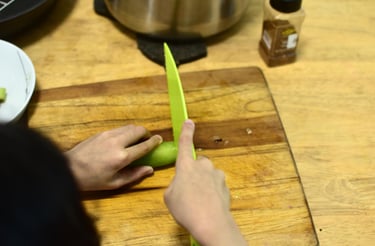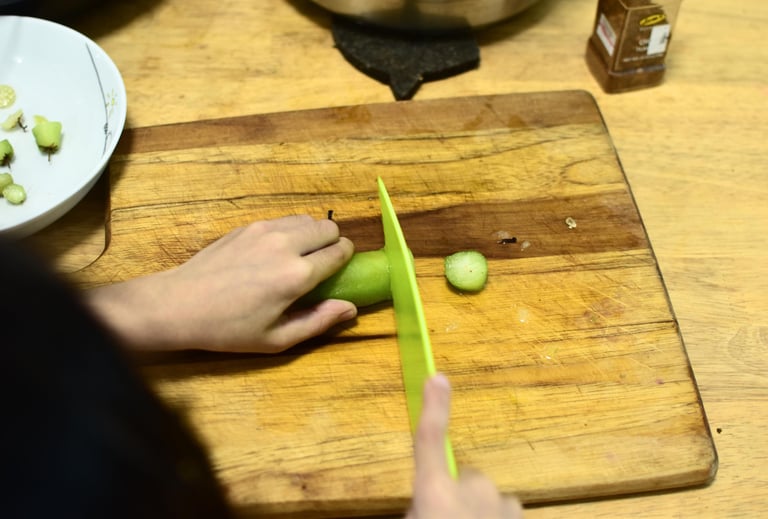Children in the Kitchen: Making Kamias Jam with the Help of Little Hands
Allowing kids to do food prep and cook in the kitchen is a learning experience, both for children and adults. Here's our experience when we made kamias or bilimbi fruit jam.
CARE
Nicole Lasam
3/22/20254 min read


A few weeks ago, my sister-in-law gave us a bag of kamias or bilimbi fruits. I knew them because our family used to have one growing in our yard in New Manila. When it was the right season, the bilimbi tree just covered itself (trunk, branches) in these very sour green fruits. Seeing them again reminded me of my childhood in that old house: playing tent in the garden, swinging in the hammock outside, watching the househelpers do the laundry, trying to make calamansi seedlings grow, and even trying to make chicks hatch from store-bought eggs… so I was excited to taste them at once!
Of course, what did I expect? They were as sour as I remember! The ones we got were still firm, meaning they still could ripen further, but they wouldn’t get any sweeter as far as I know. After we had a few, we put the fruits in the refrigerator and pondered on how to use them. It was an option to use them for sinigang (soup with soured broth), but that wouldn’t use up the entire bag.
We cooked together!
One afternoon, while three of the four children were awake and restless, I offered that we turned the kamias into jam. We looked up a video on YouTube, measured the weight of the kamias (so we could calculate the amounts of the other ingredients), and got to work.
As I was holding the baby, I couldn’t cut the kamias. We made a plan that allowed both girls to cut one fruit in turns, using the knife by themselves. A few birthdays back, we bought our eldest a lettuce knife, which was made of plastic but sharp enough to cut… well, lettuce, of course. It also happened to be sharp enough to cut kamias.


'Forward and down': Those are the instructions they follow when cutting with a knife. Oh, and 'fingers in' for the hand that holds the food to be cut!
What did we gain from this experience? Cooking with children may take a lot longer (and, undeniably, be messier), but the results are worth it:
1. It teaches the parent to be more patient and less of a perfectionist. As they are children, their work will be slower. Their cutting will not be equal in size. And that’s okay. Just allow them to work at their own pace.
2. It’s an activity that keeps the mind off screentime. We forget that our modelling influences children to want screentime—I find that the more I look at my smart phone, the more they ask for some form of screentime (“Can I look at pictures?” “Can I watch you play that spelling game?” or “Can you play the My Little Pony song?”). Being involved in a hands-on activity like cooking not only gets the children not to think about screentime but also pries the adult off it. When adults are not so attached to their device, they help children temper their hankering for it, too.
3. It engages children to focus on the task at hand. The washing, the sorting, the measuring, the setting up, and the cutting are all tasks that need commitment to complete. They gain the focus to do the knife work well and the patience to complete it—because they will have to do the same thing until all the fruits are cut up and placed in the pot.
4. It teaches kids to be careful with handling sharp and acidic things. They know what a knife is and how to use it carefully so that they don’t cut their fingers (even a blunt plastic knife will hurt if you “slice” a finger). They know that the fruits are acidic, so they shouldn’t rub their eyes while they are working.
5. It teaches children to take turns. Kids have a strong sense of justice and taking turns appeals to that. They wait for their turn and feel happy when they get it; and, knowing they will get it back, they are more willing to part with the knife again after slicing one fruit.
6. It gives the little ones an incentive to clean up after they work. We worked on the dining table because the kitchen counter was too high for them. That meant if they wanted to eat their special homemade jam, they had to clear out the table for me!
I’m happy to say our kamias jam turned out well! It was delicious to spread on buttered toast. It turned out more tart than the jam from the grocery store because—besides the fruit being one of those ultimately sour ones—I lessened the ratio of sugar to the fruit in the recipe (because I can, haha!). Also, the kamias were firm when the recipe called for squishy ones.
So, my advice for when somebody gives you a big bag of fresh tropical fruits that may just be too many to eat: look for a recipe online and cook it with the kids. It’s going to be fun for everyone!


